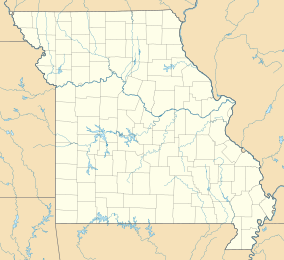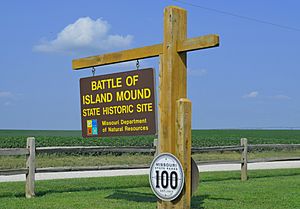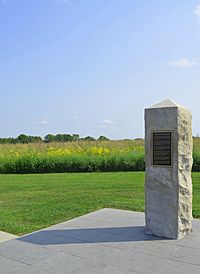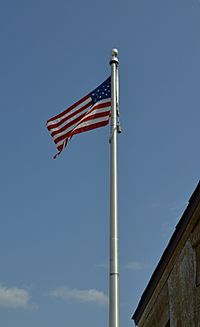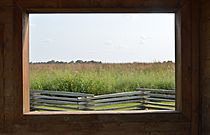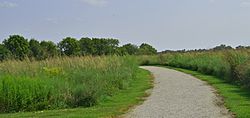Battle of Island Mound State Historic Site facts for kids
Quick facts for kids Battle of Island MoundState Historic Site |
|
|---|---|
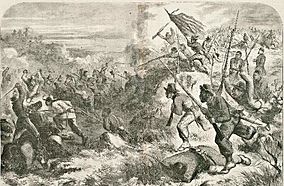 |
|
| Location | Bates, Missouri, United States |
| Area | 40 acres (16 ha) |
| Established | 2008 |
| Governing body | Missouri Department of Natural Resources |
| Website | Battle of Island Mound State Historic Site |
The Battle of Island Mound State Historic Site is a special place in Bates County, Missouri. It was created to protect the area where an important American Civil War battle happened. This battle took place on October 28–29, 1862. It was fought between soldiers from the Union side and Confederate fighters.
What makes this battle so important? It was the first time African-American soldiers fighting for the Union faced off against white enemy troops in the Civil War. A reporter from The New York Times wrote about the battle. The newspaper headline praised the "desperate bravery" of the African-American soldiers. They helped the Union win the fight.
During this time, the area was full of small groups of fighters from both sides. In this battle, the Union forces were mostly the 1st Regiment Kansas Volunteer Infantry (Colored). They were helped by parts of the 5th Regiment Kansas Volunteer Cavalry. They fought against a much larger group of Confederate fighters. These Confederate fighters were also joined by parts of the pro-Confederate Missouri State Guard.
Exploring the Historic Site
The historic site is about eight miles southwest of Butler, Missouri. It's not far from State Highway K. The site is 40 acres big. It's close to the actual battle spot, which is on private land nearby.
The site includes much of the Toothman family's land. Union troops took over this land and built temporary walls to protect themselves. They called their fort "Fort Africa." It's believed that the graves of the eight Union soldiers who died in the battle are here, but their remains haven't been found yet.
Even though The New York Times wrote about the battle and praised the bravery of the black soldiers, the site was mostly forgotten for many years. But in recent times, people became more interested in African-American history. Also, as the 150th anniversary of the Civil War got closer, interest grew again. The state of Missouri bought the land in 2008 to protect this important place. Special ceremonies were held at the site on October 26–27, 2012, almost 150 years after the battle.
In May 2013, the site became part of the National Park Service's "National Underground Railroad Network to Freedom." This network includes places important to African-American history and their fight for freedom.
-
A .6-mile walking path, the "Courage Trail," winds through the prairie flowers and grass at the Battle of Island Mound State Historic Site. During the battle, the southern force set fire to the prairie in an attempt to burn their opponents out, and the union force lit a back fire to protect itself. In the confusion that followed, much of the fighting was at extremely close quarters.
The Battle of Island Mound
The battle, sometimes called "Battle of Fort Toothman" or "Fort Africa," happened on October 28–29, 1862. The Union's 1st Regiment Kansas Volunteer Infantry (Colored) fought in this battle. These soldiers were African Americans who had been enslaved in Arkansas and Missouri. They were joined by a scouting team of Cherokee and black soldiers from the 5th Regiment Kansas Volunteer Cavalry.
They fought against a larger group of Confederate fighters. These fighters were led by Vard Cockrell and Bill Truman. The Union soldiers had crossed into Missouri to clear out Confederate fighters from their base. This base was known as "Hog Island" in the Osage River.
At first, the Union troops were outnumbered. They took over and strengthened the home of Enoch John Toothman, a Confederate fighter. A one-day battle then began. Some of the Union soldiers were caught in the tall grass by mounted Confederate fighters. They bravely held their ground through many rounds of gunfire and a cavalry charge. The Confederates finally left the area on October 29.
The Union had few losses. Seven enlisted men died, including six African Americans and one Cherokee soldier. One Union captain also died. The Confederates are thought to have lost more than thirty men.
This battle was very important because it was the first time African-American soldiers fought against Confederate forces in the Civil War. The The New York Times reporter who was with the soldiers praised their "desperate bravery." He also wrote that Bill Truman said the black soldiers fought "like tigers." Harper's Weekly also covered the battle. These positive reports encouraged other African-American units forming in the northern states. They wanted to fight in combat too. Soon after, the United States Colored Troops were formed. These troops played a very important role in helping the Union win the war.
Visiting the Site
The Battle of Island Mound State Historic Site is a great place to visit during the day. It's open from sunrise to sunset. You can go hiking and have a picnic there.
There's a main information center that tells you about the battle. Next to it, there's a .6-mile walking trail called the "Courage Trail." Along this trail, you'll find the "Courage Monument" and signs that explain more about the battle. There's also a picnic shelter that can hold up to fifty people, restrooms, and a drinking fountain near the information center.


